Uncovering the Channel Islands’ Unique Histories
Enlightening New Book by Santa Cruz Island Descendant Frederic Caire Chiles

The magical natural offerings of California’s Channel Islands rival any landscape on the planet, but the archipelago’s assembled histories are almost equally fascinating. The prehistoric and modern pioneers who’ve tended to their shores over the past 15,000 years endured all manners of triumphs and tragedies, leaving a lush fabric of stories in their wake.

Weaving all the tales together in the new book California’s Channel Islands: A History is Frederic Caire Chiles, whose great-grandfather Justinian Caire owned Santa Cruz Island around the turn of the 20th century. Chiles covered his family’s story in his last book and was asked by his publisher, the University of Oklahoma Press, to expand that work into this exhaustive and entertaining examination, which hits every island from San Miguel to San Clemente.
“In doing the Justinian Caire and Santa Cruz Island book, the story was the people: They were center stage, and the island was the background,” Chiles told me over the phone from his home in London. “In this book, the islands and all their rich history are the stars, and it’s not just a story of the last 150 years. It is a story of the last 15,000 years, and an exciting one it is.” An edited version of our interview is below, and excerpts of the book can be found on the pages that follow.
How were you introduced to the islands? I was initially inoculated by my mother. As kids, we were raised on stories of this island kingdom that had been bought by her grandfather, and it was all a very special history, a pretty unusual, unique experience. Yet somehow it was a story that you didn’t dig too far into. As long as you stuck to the level of “Wasn’t it a wonderful place?” and “Weren’t they heroic?” it was great. But if you really started to probe down through the layers and wonder, “If it was so great, why’d they get rid of it?” then we were always told, “When you’re a little older, kids.” That time never came.
What led to the books? My mother’s oldest sister had been the family lawyer, so she really knew what the story was and where all the bodies were buried. When she died, a lot of this history went with her. But fortunately, although she was dead-set against digging it all up again, she had kept very meticulous records and put them all away as though they were meant to be found after that whole generation was gone.
When did you first get to visit the island? It wasn’t until I was a graduate student at UCSB that my mother’s sister engineered a meeting with Carey Stanton in the early 1970s. He had a thing about the Caires, always wanted to cultivate and be friendly with them, but they had mixed feelings. By and large, they refused to ever go out there, but they never shut him out of the picture. He maintained a cordial relationship with them, usually at arm’s length. My younger brother was an undergrad, as well, so we met with Carey Stanton in Isla Vista, and that led to an invitation to spend some time on the island.
We spent three to four days out there and were very much taken with it. Having been [raised] on stories of this hyperactive place with 20-30 vaqueros running around as it had been, it seemed pretty sparse and lonesome. When the generator shut off, it was the quietest, darkest place within about 100 miles of Los Angeles. It was strangely beautiful and calm and quiet but different.
What did you learn in researching the book? One thing that really stuck out for me was the kind of motion that people would take on these islands to fashion them into a kingdom. Certainly, [Herbert] Lester was obvious about it, and loved calling himself the “King of San Miguel.” But on Santa Rosa, A.P. More was a self-styled king, as well. In fact, he got away with murder. He killed the Chinese cook, but the court wouldn’t convict him because it happened over water on the pier.
The Vails stand out from all of this by just being really sensible, running things as a business, not falling out with each other, and getting people to work for them for decades.
And like Frenchy LeDreau — the clown prince of Anacapa Island who lived in a quiet alcoholic haze — the islands have space for people to express their eccentricities. Not forever, and sometimes they only last five or six years, like the Hyders on Santa Barbara, which is a story I didn’t know anything about. Their dilemma encapsulated that allure and mystique of having an island to call your own, but it was just a life of unremitting toil.

Was there more heartache or pleasure for those involved with the islands? There was probably more pleasure. The heartache would come in the walking away. I didn’t come across any story where people voluntarily left. They were forced to leave by circumstances, whether it was tragedy of the Lesters or the lawsuits of the Caires and the Vails. I overheard one of the Vails saying, “I don’t care if we got $30 million. I’d give it all back if we could have the island.”
Which island is your favorite? I’ve gotta say Santa Cruz because of its unique geology. All things being equal, Santa Cruz Island is really the only one where you can get out of the wind. That wind really picks up a head of steam across the Pacific. It’s just one of these things that defines the islands. They are shaped by the wind.
Do you expect the military to ever open San Clemente or San Nicolas to the public? Those facilities are probably pretty expensive to maintain, so it really depends on the role of the military in America. If the world situation changes for the better, which is a very big “if,” then it could be that the American people would like to repurpose those islands for recreational purposes, much the same way as they have for all the military land around the San Francisco Bay. But the Navy continues to invest in San Clemente, where there’s a whole mocked up American embassy that the SEALs can practice storming. That doesn’t indicate they’re likely or want to move.
Is there a greater American lesson in how these islands were developed? They do reflect that pioneering, gung-ho, take-on-nature-on-its-own-terms spirit of the westerly movement of American history. The Lester family became minor celebrities in the 1930s; they were the Swiss Family Lester, the blue-blood pioneers, which charmed America.
But I hope to communicate that the 15,000 years of human activity on these islands is every bit as interesting and important as the last 400 or 500 years of Western, written-down history. I got swept up in the notion that, just under the surface of these islands, there’s the proof that humans spread into North and South America not only down the traditional understanding of the middle of the continent, but by following the coast, as well.
The fact that the proof hasn’t been paved over is really exciting. It’s something that Southern Californians, and Santa Barbarans, in particular, can take real pride in. They can see this great historical resource sitting there on the horizon. Even if they don’t go out and enjoy it, they can still get the reflected glory of what’s there on their doorstep.
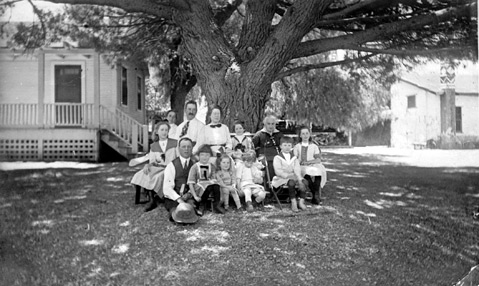
Edited Excerpts from California’s Channel Islands: A History
(296 pages; University of Oklahoma Press)
Santa Cruz Island
Xaxas (later Prisoners’ Harbor) in the predawn light, around one thousand years ago. The village of grass-covered dome houses along the stream behind the beach is beginning to stir. The smoke of cooking fires rises straight up into the windless sky. On the far mainland, mountain peaks stand out sharply. The break along the shore barely rattles the beach pebbles. Wind and water conditions are perfect for fishing and traversing the channel to the mainland, and two tomols are getting ready for departure. The navigators have been studying the sea conditions for several days and feel confident that the calm conditions will continue for a few days more. The larger of the two boats, with a crew of eight, is being loaded with stone blades, digging stick weights, fish, and abalone. These, along with several dozen strings of shell beads and an otter pelt to be exchanged for acorn meal, are watched carefully as they are placed aboard by the caped chief, who is also the owner of the tomol. The smaller tomol with its crew of four is bound for the deeper parts of the channel to hunt for ocean fish — dolphin, tuna, or swordfish. The owner of that tomol is also present in the small crowd on the beach, watching as the crew members load their nets, lines, and harpoons. The light is brightening over the eastern hills of the island. The navigators confer quietly between themselves and the owners of the tomols. Then, with a minimum of fanfare, the boats are launched into the small wavelets of the harbor. The crews start up a repetitive chant as their paddles dig into the water. The larger boat heads directly for the mountain peak that marks the navigation point for the large town of Syuxtun (Santa Barbara). The other boat turns toward the rising sun, its decorations glittering in the light. It will follow the shore along the length of the island toward the fishing grounds. The crowd disperses into the village, now fully awake and preparing for the day. …

It was the end of an era that had lasted at least ten millennia, and the beginning of a new time in the history of Santa Cruz Island. In 1821 Mexico finalized its independence from Spain, and under the leadership of Agustín de Iturbide (Agustín I) it laid claim to all the former Spanish possessions in Mexico, including Baja and Alta California. The impact of these events was felt on Santa Cruz Island only in 1830 when the Mexican government attempted to enforce an edict deporting convicted criminals to California presidios. In March that year the Maria Ester sailed into Santa Barbara with about eighty prisoners on board. Having previously been turned away from San Diego, the captain was not surprised to meet with strong resistance from the citizens of Santa Barbara. There are various stories about what ensued but one of the most widely accepted relates that after about a month of stalemate, the decision was made to deport thirty-one of the convicts, those deemed most incorrigible, to Santa Cruz Island to be left there with enough supplies to survive while they contemplated their crimes. Not long after they were put ashore a fire destroyed their provisions and the prisoners showed enough ingenuity to build rafts and sail back to the mainland where some were absorbed into the local population. Others, after a stint in the local guardhouse, were sent to the provincial capital in Monterey. They disappeared from the pages of history, but the memory of their brief sojourn on the island remains in the designation of the main harbor on its northern coastline as Prisoners’ Harbor. …
Limuw, the island of the Chumash from time immemorial, now the Island of the Holy Cross — Santa Cruz — with its intermittent livestock operation, had changed little. Now, in the early 1880s, and for more than a century, it would bear the imprint of [Justinian] Caire’s plan for commercial land husbandry across its hills, valleys and coastline. Over seventeen years his plan took shape, integrating sheep, cattle, and viticulture. Existing buildings were expanded and developed. Two kilns were constructed, one for the manufacture of bricks and the other for making limestone mortar. From these came the materials to build barns, warehouses, winery buildings, and, in 1890, a small chapel. Island stone was quarried and a resident blacksmith forged railings, balconies, fittings, and hinges. A comfortable two-story family home was built at the Main Ranch. Full-time and part-time employees included “ranch hands, team drivers, dairymen, vintners, grape pickers, sheep shearers, a wagon maker, butcher, carpenters, painters, cobbler and captain and crew of the schooner Santa Cruz.” Many of these men, particularly those associated with the rounding up and shearing of the sheep, were drawn from the local Santa Barbara population.
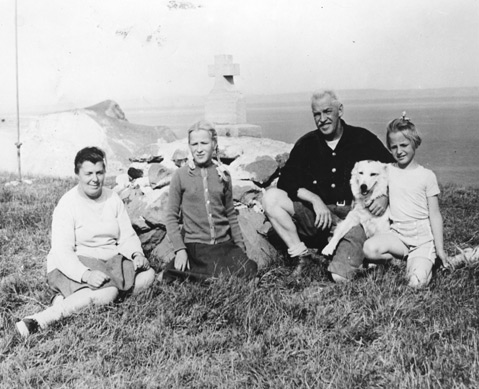
San Miguel Island
Home for Herb and Elise Lester was now the long narrow ranch complex that had been constructed twenty-five years before. … Having been raised with a household staff of seven, Elise Lester found the challenges of homemaking novel and exciting, working alongside her husband to domesticate the living conditions. Herb built a brick-and-stone fireplace that turned the living room into a cozy library and added many other features to his wife’s homey touches.
There was much more to be done all over the island. Like his predecessors, Lester continued the tradition of proclaiming himself King of San Miguel. He found that island life suited him perfectly, and he seldom went to the mainland, much preferring the solitary splendor of his kingdom. The same was true for the rest of his family, which grew to include two daughters, Betsy and Marianne, born in 1930 and 1933. They and their mother remained in Santa Barbara after their births only until they had reached the statutory ten pounds, then they were off to San Miguel. …
There was a feature article in Life magazine in which they were dubbed the Swiss Family Lester. Journalists found the Lesters’ story irresistible. They were a couple from comfortable circumstances but showed pioneering spirit in adapting to the rough, self-reliant island life. The incongruity of details, like the use of Elise’s silver tea service, only added to the romance of their circumstances. …
An infrequent supply boat brought them provisions, and family friend George Hammond, an early aviator with an airfield on his Montecito estate, flew in mail, stores, and small packages of Santa Barbara delicacies when the weather was favorable. Carrying a mailbag marked “George F. Hammond, Bonnymede, Air Mail, Kingdom of San Miguel Island,” he landed on “Hammond Field,” a nine-hundred-foot stretch of grassland east of the ranch complex, complete with boundary markers and a wind sock.
Herbert Lester developed a collection of San Miguel memorabilia for his “Killer Whale Bar,” flotsam and jetsam collected from the island beaches. The house’s walls were graced with the skulls of a ram and a Steller sea lion, the dried head of a mako shark, framed covers and liquor ads from the New Yorker magazine, and even a lithograph of a nude woman. It was here that Lester held forth to the delight of scores of fascinated visitors. The house’s enclosed yard was littered with lifeboats, ships’ tackle, casks, a “school bell” contributed by the Southern Pacific Railroad, and even fossilized remains of Pleistocene pygmy mammoths discovered by Lester.
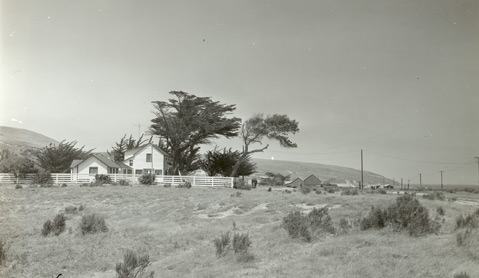
Santa Rosa Island
The military’s interest in Santa Rosa Island was reawakened with the dawn of the Cold War, as postwar tensions with Russia and China over the Pacific Rim grew in the 1940s and 1950s. …
Staff worked an eighteen-month tour of duty, with three days leave a month, diverting themselves during off-duty time with music, pool, and table tennis, but the Vails forbade hiking or hunting as threats to their cattle. Morale was “surprisingly good.” One of the airmen described it as being like “on a South Pacific island, except for the monthly visit to the mainland.”
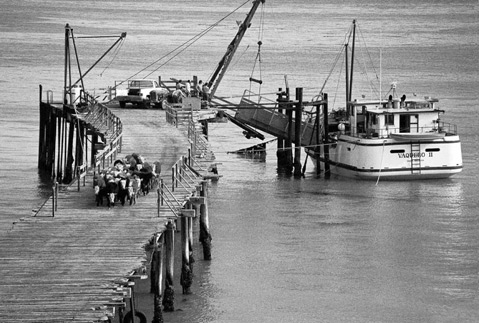
The ranchers got on well with the air force contingent, and there was regular interaction, with a bar at the Johnsons Lee base becoming popular with both the Vails and their cowboys. There was even a formal dress occasion when the Vails took the Vaquero II around the island to call on their military neighbors. There were points of contention from time to time, when enlisted men trespassed or cows chewed telephone cables, but there was prevailing Santa Rosa Island goodwill on both sides. The ranchers provided meat for barbecues and the air force invited the cowboys over for movies and beer. …
The same forces that had inspired the sale and breakup of the huge Vail and Vickers holdings in Riverside County — the booming economy, population growth, and the call for more recreational opportunities and environmental awareness — would also affect the company’s tenure on Santa Rosa Island. After the increase in environmental awareness of the 1960s and 1970s and the insatiable demand for unspoiled recreation space, the long-debated Channel Islands National Park was finally authorized by President Jimmy Carter in 1980. It changed the islands of Anacapa and Santa Barbara from national monument status and added the other three northern islands. The Vail family made clear its objections to being included in the park, traveling to Washington twice to argue against inclusion, eventually winning a compromise whereby the Vails could continue their ranching and commercial hunting operations for twenty-five years once the park was established and the island purchased. …
In 1993 the National Park Service approved a range management plan. Although a second five-year ranching permit was signed, and most of the scientific community within the federal agencies agreed that the Vail and Vickers Company was an excellent steward of the land, ultimately the NPS came to the conclusion that livestock production was not compatible with environmental protection. … At the end of 1996 the NPS felt compelled to reevaluate the responsibilities between it and Vail and Vickers. Suits and countersuits were threatened. Faced with lengthy litigation and potential loss, Vail and Vickers consented to a settlement agreement that would phase out hunting and end the historic ranching operation. By 1998, just one steer remained on the island, in a corral at Bechers Bay.

Anacapa Island
After Eatons’ lease expired, there were no official tenants at first, but the vacuum was quickly filled by Raymond (Frenchy) LeDreau, who moved onto West Anacapa. A native of Brittany in western France, he had studied for the priesthood, become disillusioned with the church, and gone to sea. He is said to have joined the U.S. Navy and then the U.S. merchant marine. While on leave from a merchant ship in California, he met a local woman and they had three children. She died in the 1918 flu pandemic, and in his grief Frenchy sank into a life of reclusive drinking and fishing.
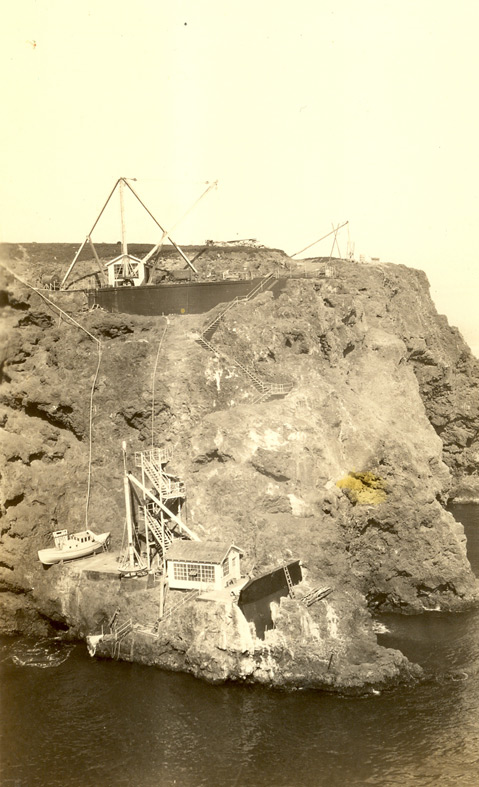
During Prohibition, Frenchy’s income seemed to have derived mostly from bootleggers and rumrunners who used the caves of the islet or even Frenchy’s chicken coop for storing their product. With his fondness for drink, Frenchy was a natural partner for the local alcohol suppliers, often taking partial payment for his services in the product itself. After the repeal of Prohibition, Frenchy stayed on, living in the largest of four board-and-batten shacks that lined the bluffs of the cove on West Anacapa that had acquired his name. These had been built in 1925 by Ventura promoters with ideas of developing a sport-fishing club on Anacapa. Frenchy made his shack more comfortable by using magazine pictures for insulation, and he created a lifestyle that suited his simple tastes. Although often short of water, which he would cadge from passing yachts or, when necessary, from a brackish seep in a nearby cave, he got by with pet cats for companionship. He had handy access to his skiff, lobster traps, and fishing gear, which ensured him a constant supply of food. Frenchy became widely known by Pacific Coast fishermen as an agreeable and welcoming recluse who enjoyed company and was always ready to trade some fresh lobster for water or something stronger to drink.
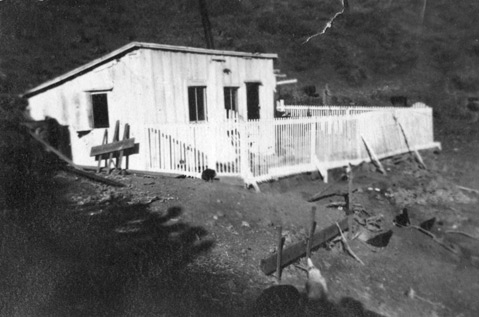
Santa Barbara Island
On a rainy morning in January 1916, Alvin and Annie Hyder and their two children, Nora and Buster, set sail in Nora II for Santa Barbara Island with all the household goods they would need to build an island life, including lumber to construct a house. They started their existence there in a humble two-room structure above Landing Cove constructed the year before by Alvin and two of his brothers. Anchored to the ground by cables to prevent it blowing off the cliff, it was home to two families, with Alvin Hyder’s family in one room and that of his brother Clarence in the other. They built a barn and chicken houses close by. The Hyders devised a wooden sled and track that ran from the cove to the top of the hill where supplies were destined to be used and stored. The hauling power was supplied by their horse, Old Dan. The sled tracks were attached to the rock by metal spikes set in hand-drilled holes filled in with cement. They can still be seen along the hillside between the cove and the location where the Hyder buildings once stood.
4•1•1
California’s Channel Islands: A History by Frederic Caire Chiles can be purchased at Chaucer’s Books, other santa barbara bookstores, and at oupress.com



